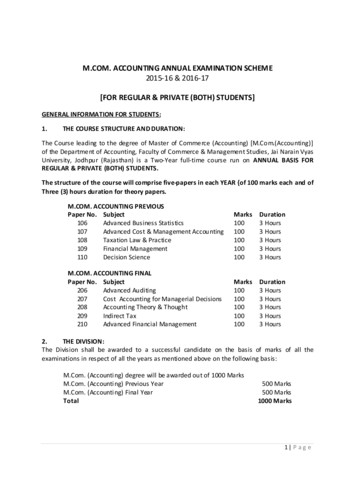Province Ide Urveillance - Alberta Health Services
Province Wide SurveillanceSurveillance for the identification of healthcare-associated infections is anessential component of AHS’ response to the hazard these infectionspose to Albertans. Infections under surveillance are selected based on thosethat have a significant cost to the healthcare system or significant impact onpatient morbidity or mortality. Surveillance for IPC purposes is different thanthe clinical assessment of information for patient diagnosis and treatment andso is carried out in a distinct manner.Provincial performance andmonitoring measuresAHS has 13 performance measures aligned withthe AHS 2017-2020 Health Plan and BusinessPlan used to monitor the performance of thehealth system. AHS IPC provides the data for theperformance measure on hand hygiene compliancethat is used as an indicator to reduce and preventincidents of preventable harm to patients in AHSfacilities. Covenant Health is not included inthis performance measure due to differences inmethodology. AHS also has several monitoringmeasures, one of which is the hospital-acquiredClostridium difficile infection rate that is providedby AHS IPC, and includes both AHS and CovenantHealth facilities. From 2016/17 to 2020/21, thehospital-acquired Clostridium difficile infection ratein AHS and Covenant Health facilities decreasedby 23.5 per cent. In 2020/21, the rate was 2.6 per10,000 patient days, which was below the CanadianNosocomial Infection Surveillance Program (CNISP)benchmark of 3.38 per 10,000 patient days.IPC 2020/21 Annual Report to Alberta HealthProvince Wide SurveillanceProvincial IPC researchpriority settingIn 2019/20, the IPC Research Priority SettingPlanning Committee was established to overseethe design, execution, and analysis of the researchpriority setting project in accordance with establishedDelphi and consensus methods. The committeeorganizes and is accountable for the key decisionsmade about priority setting activities. Due to theCOVID-19 pandemic, the work of the committeewas postponed.Throughout the COVID-19 pandemic, IPC staff andphysicians participated in or supported the AHSScientific Advisory Group. This group connectswith clinicians, operational leaders, researchers,and other experts to review emerging evidenceand guidance from national and internationalbodies to provide information about focused areasof healthcare related to COVID-19. Resources arecreated to provide research-informed advice to AHSphysicians, staff, patients, and families and areposted on the Scientific Advisory Group COVID-19Recommendations webpage on the external AHSwebsite.
Provincial IPC surveillance programAHS IPC has an integrated provincial surveillance program. Surveillance protocols are developed andapproved by provincial IPC groups and committees and applied in a consistent manner across AHS andCovenant Health. There are ten provincial IPC surveillance protocols related to outcome measures (Table 2).Table 2: Provincial IPC surveillance protocols related to outcome smsLaboratory-confirmed carbapenemase-producing organisms in acute care settingsLaboratory-confirmed methicillin-resistant Staphylococcus aureus colonizations and infections in acute care settingsLaboratory-confirmed vancomycin-resistant enterococcus infections in acute care settingsBloodstreaminfectionsLaboratory-confirmed bloodstream infections with antibiotic-resistant organisms including carbapenemase-producingorganisms, extended-spectrum beta-lactamase-producing organisms, methicillin-resistant Staphylococcus aureus, andvancomycin-resistant enterococcus in all admitted patients and central line-associated bloodstream infections in adult andpediatric intensive care unitsClostridium difficileinfectionLaboratory-confirmed with clinical signs and symptoms in an acute care settingSurgical siteinfectionsEligible cardiovascular procedures including coronary artery bypass graft or cardiac procedures that involve valvereplacement, septum repair, and reconstruction proceduresLaboratory-confirmed in a continuing care settingEligible orthopedic procedures including total hip or total knee replacementEligible vascular procedures including abdominal aortic aneurysm and peripheral vascular bypass proceduresAll protocols are posted on the Surveillance & Reporting webpage on the external AHS IPC website and areupdated on an annual basis. Where appropriate, these protocols align with national and international surveillanceprotocols, allowing comparison between Alberta’s health system and other jurisdictions in Canada.The provincial IPC surveillance platform enables the collection and reporting of surveillance data for outcomemeasures. Vendor-supported platforms – AHS Clean Hands and AHS Medical Device Reprocessing Reviews –enable the collection and reporting of surveillance data for process measures, which are described elsewhere inthis report. Education and training for staff are provided before platform access is granted to promote accuracyand validity of the data.Local IPC surveillance programsLocal surveillance protocols are also accommodated in the provincial surveillance platform. These surveillanceinitiatives are based on needs identified at the local level. For example, sites can target a specific surgicalprocedure of local importance.IPC 2020/21 Annual Report to Alberta HealthProvince Wide Surveillance2
Review of surveillance trends for 2020/21The data demonstrate that hospital-acquired infections remained stable throughout 2020/21 as shown in thefigures below (Figure 2 and Figure 3).Figure 2: Provincial hospital-acquired methicillin-resistant Staphylococcus aureus colonization andinfection rates, 2016/17 to 2020/21MRSA Methicillin-resistant Staphylococcus aureusData are accurate of May 17, 2021IPC 2020/21 Annual Report to Alberta HealthProvince Wide Surveillance3
Figure 3: Hospital-acquired Clostridium difficile infection rate, 2016/17 to 2020/21CDI Clostridium difficile infectionData are accurate of May 17, 2021IPC 2020/21 Annual Report to Alberta HealthProvince Wide Surveillance4
All deaths in patients with Clostridium difficile infection occurring within 30 days of diagnosis are reviewed by IPCphysicians prior to inclusion in reporting. Through 2020/21, an increase in Clostridium difficile infection attributablemortality was observed for community-acquired cases compared to hospital-acquired and healthcare-associatedcases (Figure 4). Adverse outcomes are reported quarterly to AHS and Covenant Health leaders, and to clinicalstakeholders, and are posted on the internal AHS IPC website and the AHS Tableau website.Figure 4: Clostridium difficile infection attributable mortality rate by case classification,2016/17 to 2020/21CDI Clostridium difficile infectionData are accurate of May 17, 2021During 2020/21, total-hip and total-knee surgical procedures and surveillance for surgical site infections followingthose procedures continued intermittently. Further case finding and case review will be performed to calculatethe surgical site infection rates for the fiscal year when capacity permits.IPC 2020/21 Annual Report to Alberta HealthProvince Wide Surveillance5
IPC COVID-19 surveillance responseIn response to the COVID-19 pandemic, Alberta Health and AHS implemented surveillance activities forCOVID-19 in Alberta. The Provincial Surveillance Information system is a laboratory surveillance system thatreceives positive results for all notifiable diseases and diseases under laboratory surveillance from AlbertaPrecision Labs. The system also receives negative results for a subset of organisms such as COVID-19.The Communicable Disease Reporting System at Alberta Health and the Communicable Disease OutbreakManagement system at AHS contain information on COVID-19 cases.Data Integration and Measurement Reporting database at AHS contains up to date information on people admittedand discharged from hospital in Alberta. Information such as hospitalizations and admissions to intensive careunits are submitted to Alberta Health from AHS through enhanced case report forms.In late 2019/20, AHS IPC collaborated with the Canadian Nosocomial Infection Surveillance Program (CNISP) tocreate a national IPC surveillance protocol. A supporting module was developed in the provincial IPC surveillanceplatform to monitor inpatient cases of COVID-19 in 102 Alberta acute care facilities and identify COVID-19acquisition as hospital-acquired, healthcare-associated, or community-acquired. Agreement with Alberta Healthwas reached before starting this work.In 2020/21, the protocol and module launched with data collected in March 2020 being entered retrospectively.To support those IPC staff responsible for entering data, the COVID-19 User Guide was released in 2020/21 anddata quality meetings were offered regularly. Zone-specific reports were distributed weekly to AHS IPC.Throughout 2020/21, weekly aggregate data from all Alberta acute care facilities was provided to the CanadianNosocomial Infection Surveillance Program (CNISP). Anonymized patient questionnaires from Calgary acutecare sites, the Stollery Children’s Hospital and the University of Alberta Hospital were submitted regularly.IPC 2020/21 Annual Report to Alberta HealthProvince Wide Surveillance6
During 2020/21, patients hospitalized with COVID-19 primarily acquired their infection in the community (Figure5). However, in Q3: October-December 2020, there was a sharp rise in the rate of both community-acquired casefrom 45.4 to 334 per 1,000 admissions and hospital-acquired cases from 0.67 to 5.43 per 10,000 patient-days.Figure 5: Hospitalized COVID-19 cases by case classification**Data are accurate of May 17, 2021. The hospitalized COVID-19 cases by case classification are derived from the provincial surveillance protocol developed by IPC.The hospitalized COVID-19 cases may be different than the cases reported elsewhere by Alberta Health or by other areas within AHS due to the use of different datasystems.Throughout the pandemic, Alberta Health, AHS IPC, Alberta Precision Laboratories, and AHS ProvincialPopulation and Public Health, continued to clarify the goals of COVID-19 surveillance and to share cases andinformation. Work continues to confirm alignment between the various sources of information that compriseCOVID-19 surveillance activities in the province.IPC 2020/21 Annual Report to Alberta HealthProvince Wide Surveillance7
Impact of COVID-19 on surveillance activitiesAt different times throughout 2020/21, select provincial and local surveillance activities were suspended soinfection control professionals could better support their healthcare sites and units. For those surveillanceactivities that were not suspended, epidemiologists and analysts explored how this work could be diverted fromfrontline infection control professionals. Where usual surveillance processes needed to be changed, data linkageprocesses were used to capture missed events for the following surveillance initiatives: Laboratory-confirmed vancomycin-resistant enterococcus infections; Bloodstream infections with antibiotic-resistant organisms including carbapenemase-producing organisms,extended-spectrum beta-lactamase-producing organisms, methicillin-resistant Staphylococcus aureus,and vancomycin-resistant enterococcus in all admitted patients; Eligible cardiovascular procedures including coronary artery bypass graft or cardiac procedures thatinvolve valve replacement, septum repair, and reconstruction procedures; Eligible orthopedic proceduresincluding total hip or total knee replacement; and Eligible vascular procedures including abdominal aortic aneurysm and peripheral vascularbypass procedures.This work demonstrates that during the pandemic response AHS IPC continued to support the safety of allpatients by finding ways to continue provincial and local surveillance activities.IPC 2020/21 Annual Report to Alberta HealthProvince Wide Surveillance8
n response to the COVID-19 pandemic, Alberta Health and AHS implemented surveillance activities for COVID-19 in Alberta. The Provincial Surveillance Information system is a laboratory surveillance system that receives positive results for all notifiable diseases and diseases under laboratory surveillance from Alberta Precision Labs.
Chapter 1: MPLAB IDE Preview – An overview of what MPLAB IDE is and how it works. Chapter 2: MPLAB IDE Installation – How to install MPLAB IDE on your computer. Chapter 3: Getting Started with MPLAB IDE – A Tutorial – How to begin using MPLAB IDE. Chapter 4: MPLAB IDE Projects Tuto
EDMONTON, Alberta TOE 6A5 Phone (780) 438-1460 Fax (780) 437-7125 www.thurber.ca ALBERTA TRANSPORTATION LANDSLIDE RISK ASSESSMENT MR THURBER . Alberta (83-0)." 5. Alberta Research Council, 1976. "Bedrock Topography of the Lesser Slave Lake Map Area, NTS 83 0, Alberta." 6. University and Government of Alberta, 1969. "Atlas of Alberta."
2021 Canadian Plumbing & HVAC Industry Competitive Analysis By Province www.plumbermarketing.ca Page 7 of 17 Alberta There are approximately 475 households and businesses per plumbing & HVAC company in Alberta, making it the most competitive province in Canada. With 4,067,175 people, Alberta is the fourth largest province by population.
Alberta Native Friendship Centres Association . School of Public Health, University of Alberta Ever Active Schools Kainai Board of Education Alberta Health Services Alberta Recreation and Parks Association Nature Alberta Future Leaders Program, Alberta Sport, Recreation, . and gaming. It is through these opportunities that education occurs.
Alberta Interpretation Act Timelines outlined within the Bylaw shall be complied with pursuant to the Alberta Interpretation Act, as amended, Alberta Building Code In the case where this bylaw conflicts with the Alberta Building Code, the Alberta Building Code shall prevail, Alberta Land Titles
ALBERTA Philip Lee 1 and Cheryl Smyth 2 1 Forest Resources Business Unit, Alberta Research Council, Vegreville, Alberta Canada T9C 1T4. Present address: Senior Research Associate, Integrated Landscape Management Program, Department of Biological Sciences, Biological Sciences Building, University of Alberta, Edmonton, Alberta, Canada T6G 2E9.
1 Alberta Research Council, P.O. Bag 4000, Vegreville, Alberta T9C 1T4 2 Present address: Alberta Conservation Association, 6th Floor, Great West Life Building, 9920-108 Street, Edmonton, Alberta T5K 2M4 3 Alberta Conservation Association, Northwest Business Unit, Bag 9000,
PAPER III (PAPER 108): TAXATION LAW & PRACTICE UNIT 1: Income Tax Law, Scheme of Taxation, Important Concepts, Constitutional Provisions: Central and State Subjects; Distribution of tax proceeds among the States and Central - a brief study. Scope of Total Income and Residential Status,


















